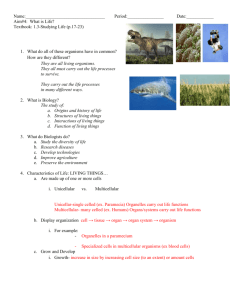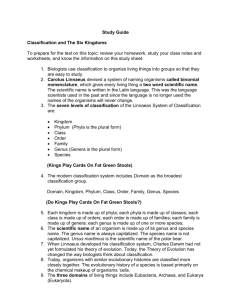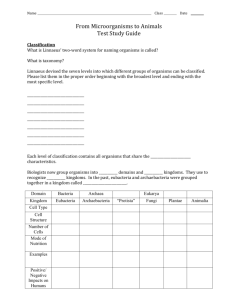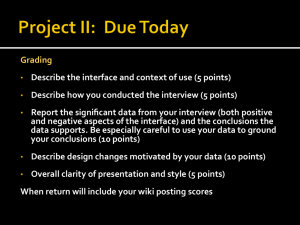Classification and 6 Kingdom Research Paper
advertisement
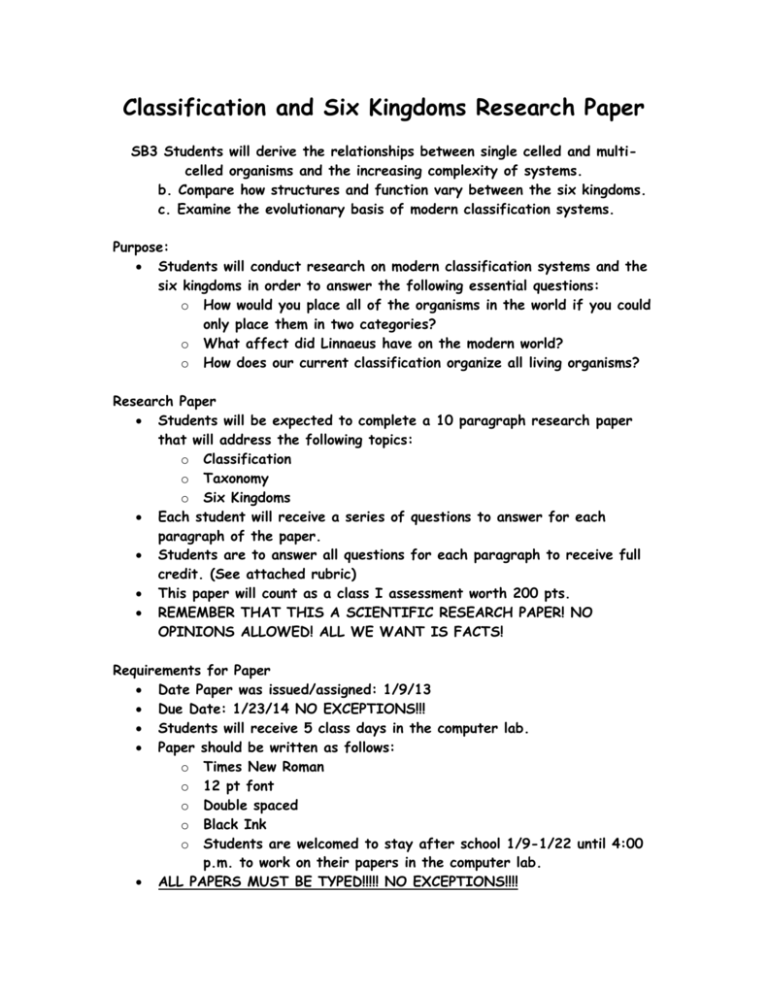
Classification and Six Kingdoms Research Paper SB3 Students will derive the relationships between single celled and multicelled organisms and the increasing complexity of systems. b. Compare how structures and function vary between the six kingdoms. c. Examine the evolutionary basis of modern classification systems. Purpose: Students will conduct research on modern classification systems and the six kingdoms in order to answer the following essential questions: o How would you place all of the organisms in the world if you could only place them in two categories? o What affect did Linnaeus have on the modern world? o How does our current classification organize all living organisms? Research Paper Students will be expected to complete a 10 paragraph research paper that will address the following topics: o Classification o Taxonomy o Six Kingdoms Each student will receive a series of questions to answer for each paragraph of the paper. Students are to answer all questions for each paragraph to receive full credit. (See attached rubric) This paper will count as a class I assessment worth 200 pts. REMEMBER THAT THIS A SCIENTIFIC RESEARCH PAPER! NO OPINIONS ALLOWED! ALL WE WANT IS FACTS! Requirements for Paper Date Paper was issued/assigned: 1/9/13 Due Date: 1/23/14 NO EXCEPTIONS!!! Students will receive 5 class days in the computer lab. Paper should be written as follows: o Times New Roman o 12 pt font o Double spaced o Black Ink o Students are welcomed to stay after school 1/9-1/22 until 4:00 p.m. to work on their papers in the computer lab. ALL PAPERS MUST BE TYPED!!!!! NO EXCEPTIONS!!!! Questions for each paragraph Classification (2pts each) 10 pt total o Define Classification o What are the benefits to classifying organism? o Who was Aristotle? o What was his contribution to classification? o What two categories were used to classify organisms? Taxonomy (1 pt each) 10 pt total o What is taxonomy? o How is the Father of Taxonomy? o What did he do differently than Aristotle? o Explain the modern classification system. o What What is a taxon? What is the broadest taxon? What is the most specific taxon? is binomial nomenclature? What language is used? What two taxons are used? How do you write it? Why do scientist use this naming system used? Archaebacteria (1 pt each) 11 pt total o Picture o What domain do archaebacteria belong to? o What is another name that scientist use to classify these organisms? o What are archaebateria? o What type of cell is it? o What is in its cell wall? o Number of cells (multi- or single celled)? o How does it obtain nutrition? o Where does it live? o How does it reproduce? o What are the three categories of archaebacteria? Give an example of each. Eubacteria (1 pt each) 11 pt total o Picture What domain do eubacteria belong to? What are eubacteria? What type of cell is it? What is in its cell wall? Number of cells (multi- or single celled)? How does it obtain nutrition? Where does it live? How does it reproduce? What are the three shapes of eubacteria and are they all harmful? o What are some examples? o o o o o o o o o Protista (1 pt each) 11 pt total o Picture o What domain do protista belong to? o What type of cell is it? o What is in its cell wall? o Number of cells (multi- or single celled)? o How does it obtain nutrition? o Where does it live? o How does it reproduce? o What are the three general categories of protista? Give an example of each. o Are they mobile? If so, how do they move? o What do we call animal like protist? Fungi o o o o o o o o o o o (1 pt each) 11 pt total Picture What domain do fungi belong to? What type of cell is it? What is in its cell wall? Number of cells (multi- or single celled)? How does it obtain nutrition? Where does it live? How does it reproduce? What are some examples of specific fungi? What disease do fungi cause? How are fungi helpful to humans? Plantae (1 pt each) 10 pt total o Picture o What domain do plantae belong to? o What type of cell is it? o What is in its cell wall? o Number of cells (multi- or single celled)? o How does it obtain nutrition? o Where does it live? o How does it reproduce? o What are specific types of plantae? o How do plantae retain water? o Are organisms in this kingdom mobile? Animalia (1 pt each) 11 pt total o Picture o What domain do animalia belong to? o What type of cell is it? o What is in its cell wall? o Number of cells (multi- or single celled)? o How does it obtain nutrition? o Where does it live? o How does it reproduce? o Are members of this kingdom mobile? o What are some of the general categories of organisms in this kingdom? o Give an example of each. Conclusion 4 pt total o Compare early classification systems and modern classification systems How are they alike? How are they different? Who contributed to which system? Which had the most impact? Grammar and structure 10 pts o See rubric







